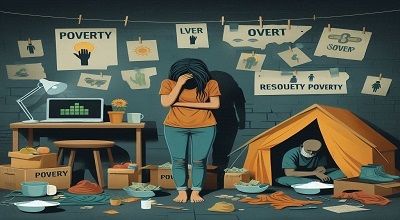Poverty
Poverty is a complex and multifaceted concept that can be defined in various ways. It is often measured and understood differently in different contexts and by different organizations. However, a common way to define povert y is as a condition in which an individual. Or a group of individuals lacks the financial resources or access to basic necessities necessary to meet their basic needs and enjoy a minimal standard of living.
Here are some key aspects and types of poverty:
- Absolute Poverty: This type of poverty is defined by a specific income threshold below. Which individuals or households are considered to be living in povert y. The threshold is often set based on the cost of a basic basket of goods and services required to meet minimum human needs. Such as food, shelter, clothing, and healthcare. The World Bank, for example, has set the international povert y line at $1.90 per day, adjusted for purchasing power parity.
- Relative Poverty: Relative poverty is a measure of povert y that considers a person’s. Or a group’s income and resources in relation to the wider society or community in which they live. It focuses on disparities in income and standards of living within a particular society. People in relative povert y may have their basic needs met but still lack the resources to participate fully in the activities and opportunities available to others in their society.
- Rural Poverty vs. Urban Poverty: Povert y can also be categorized based on the geographic location of individuals or communities. Rural povert y refers to povert y experienced in rural areas, often associated with limited access to education, healthcare, and job opportunities. Urban povert y, on the other hand, is povert y experienced in urban or metropolitan areas and may be linked to issues. Such as high living costs, inadequate housing, and unemployment.
- Chronic Poverty: Chronic poverty refers to long-term or persistent povert y that affects individuals or families over an extended period. It is often associated with factors such as limited access to education, healthcare, and job opportunities, as well as systemic disadvantages.
More read…
- Transient Poverty: Transient povert y is a temporary condition where individuals or families experience. Povert y for a short duration due to factors like job loss, illness, or other sudden economic shocks. Transient povert y is often episodic and can be overcome with time.
- Multidimensional Poverty: This approach considers povert y as a multidimensional issue, taking into account not only income. But also factors like access to education, healthcare, clean water, housing, and other essential services. The United Nations Development Programme (UNDP) uses the Human Development Index (HDI) to assess multidimensional povert y.
- Child Poverty: Child povert y specifically focuses on the well-being and living conditions of children. It considers whether children have access to basic needs such as food, clean water, education, and healthcare. Child povert y can have long-term effects on a child’s development and future opportunities.
- Gender Poverty: Gender povert y looks at how povert y affects men and women differently, often due to gender-based discrimination and inequalities. Women, in many societies, are more likely to experience povert y due to disparities in income, education, and employment opportunities.
Summary
It’s important to recognize that poverty is a complex issue with numerous contributing factors, and addressing. It often requires comprehensive strategies that encompass economic, social, and political dimensions. Different organizations, governments, and researchers may use different definitions and measures of povert y based on their specific goals and contexts.
